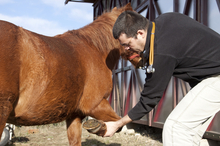In a recent article for Veterinary Practice News, David W. Ramey, DVM discusses the 5 things horse owners should look for when they suspect that their horse has an equine field fracture

Veterinarian examining horse's leg
Some fractures have a fairly good prognosis for a complete recovery, while other fracture repairs can result in horses that, while not athletically sound, are comfortable and able to live good lives.
"The size, strength and unpredictable nature of the horse makes accidents almost inevitable. While many horses escape from harrowing situations with relatively minor injuries, sometimes the damage is life- or career-threatening."
"Before treating or referring any equine fracture in a field setting, the attending veterinarian must have a good idea of the pluses and minuses of treatment and have frank discussions with the client about the cost of care and potential outcomes. Here are some factors to consider."
1. What kind of fracture is it?
"Not all fractures have the same considerations, of course. A fracture inside the hoof capsule is quite different than a compound long-bone fracture. Some fractures have a fairly good prognosis for a complete recovery, while other fracture repairs can result in horses that, while not athletically sound, are comfortable and able to live good lives.
Unfortunately, some fractures pose insurmountable problems, especially limb fractures that occur at exercise. A horse is pretty much built to the limit of its mechanical tolerance. With its muscular body and relatively thin legs, a horse canât be much bigger than it is.
As such, when a horse is running, turning, jumping, pivoting or otherwise exercising, itâs putting stresses on its limbs that are up to the maximum of what can be tolerated. When those stresses exceed tolerance, an explosionâalmost literallyâerupts in the leg.
Under those circumstances, thereâs little left to fix. Bone not only fractures into pieces, but blood vessels can tear, tendons rupture and ligaments shear off the bone.
Even when repairs of such injuries are successful, secondary complications, such as supporting limb laminitis ultimately can be insurmountable, as was the case with Barbaro, the 2006 Kentucky Derby winner."
2. Whereâs the break?
"A crack in the middle of a long bone might heal during rest. On the other hand, a crack thatâs into a joint can lead to chronic osteoarthritis. If the joint is relatively low motion, such as the pastern, fracture repair may be possible, but surgical arthrodesis might be required. However, arthrodesis is much more difficult for the horse to tolerate if the metacarpophalangeal joint is involved.
The more proximal the fractures, the more difficult is a successful repair. Upper limb fracture
Upper limb fracture repairs are extremely difficult to repair for several reasons. Adequate surgical access is incredibly challenging and requires damaging excessive amounts of normal tissue to get adequate visualization of the surgical site for stabilization.
The forces placed on the implants in the upper limbs are almost unimaginable. The horseâs leg muscle strength can distract the repaired tissues, and forces placed on an implant can bend it easily. In addition, adequate stabilization of upper limb fractures is essentially impossible."
3. How bad is the fracture?
"In general, the worse the fracture, the worse it is for the horse. For example, extremely comminuted fracturesâso-called âbags of glassââsimply canât be put back. On the other hand, a simple crack in the third phalanx may simply require rest and hoof stabilization. Even the best surgeons canât fix the worst fractures, because thereâs often very little left to fix."
4. How is the horse used?
"Sometimes, even though a fracture may be repairable, the outcome might not be desirable for the horse or the owner. A fracture repair that would result in chronic lameness, such as repair of a metacarpophalangeal joint, might be acceptable to an owner looking to use the horse for breeding but might be completely undesirable if the client wants to ride the animal.
Whereas the cost of surgery may be a worthy investment with a valuable, many owners might feel differently about a lame horse that canât be ridden for years after repair."
Please see Dr. Ramey's article in which he discusses the cost of surgery to repair a fracture and the factors that enter into making the decision about whether to repair the fracture or not, depending on the circumstances.
